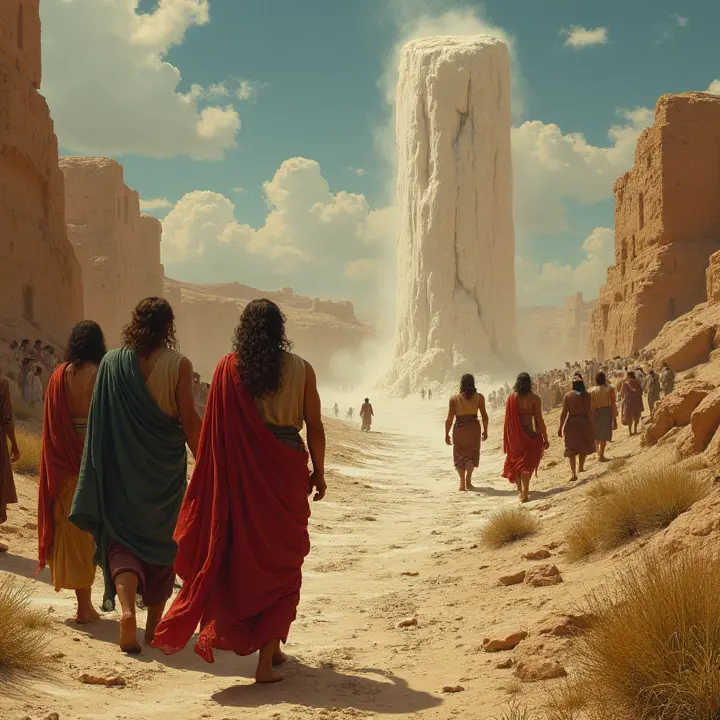In the vast tapestry of biblical narratives, the stories of women often serve as poignant reminders of the complexities of human nature and the divine plan. One such story is that of Lot’s wife and daughters, a tale intricately woven into the fabric of the Old Testament, specifically in the Book of Genesis. This narrative unfolds against the backdrop of the ancient cities of Sodom and Gomorrah, places notorious for their wickedness and destined for divine retribution. It is a story that highlights themes of faith, disobedience, and the consequences of human choices, all seen through the lens of the women involved.
Lot, a nephew of the patriarch Abraham, found himself living in Sodom, a city teeming with corruption and sin. Despite its moral decay, Lot chose to reside there, perhaps drawn by the promise of wealth and prosperity. However, his presence in Sodom was not without its challenges. The Lord, in His wisdom and justice, decided to destroy the cities of Sodom and Gomorrah, sparing only those who were righteous. In this context, Lot was deemed worthy of rescue, primarily due to his association with Abraham, who was known for his unwavering faith and obedience to God.
When the angels of the Lord came to Lot, they urged him to leave the city immediately, taking only his family. The urgency of the situation was palpable, as the destruction of Sodom and Gomorrah was imminent. Lot hesitated at first, perhaps reluctant to abandon his life and possessions. However, with divine intervention, he was persuaded to flee. The instructions given to Lot and his family were clear and concise: they were to leave the city without looking back. This command was not arbitrary but carried profound significance, symbolizing the need to break free from the past and the sins that had defined Sodom.
Among those who accompanied Lot in his escape were his wife and two daughters. These women, though secondary characters in the narrative, play a crucial role in the unfolding drama. Lot’s wife, whose name is not mentioned in the Bible, is perhaps one of the most tragic figures in this story. As they fled the doomed city, she was overcome by curiosity or perhaps a longing for the life she was leaving behind. Despite the explicit warning, she looked back, and in that moment, she was turned into a pillar of salt. Her fate serves as a stark reminder of the consequences of disobedience. Her action was not merely a glance but a symbol of her inability to fully detach from the corrupt world she was escaping. In looking back, she demonstrated a lack of faith in the divine plan and a reluctance to embrace the new life that lay ahead.
The daughters of Lot, on the other hand, present a different facet of the story. After the destruction of Sodom and Gomorrah, Lot and his daughters found themselves in a desolate place, far removed from civilization. The loss of their mother and the traumatic events they had witnessed left them in a state of fear and uncertainty. In their isolation, the daughters feared that they would never find husbands and that their lineage would come to an end. Driven by desperation and a desire to preserve their family line, they devised a plan to ensure their survival. They got their father drunk and, in his intoxicated state, conceived children with him. This act, though morally reprehensible, was motivated by their fear of extinction and a distorted sense of duty.
The story of Lot’s daughters raises several ethical and moral questions. Their actions can be seen as a desperate response to the extreme circumstances they faced. However, they also highlight the complexities of human nature and the lengths to which individuals might go to secure their future. The children born from this incestuous union, Moab and Ben-Ammi, went on to become the ancestors of the Moabites and Ammonites, respectively. Their descendants would later play significant roles in the biblical narrative, often as adversaries of the Israelites. Thus, the actions of Lot’s daughters had far-reaching consequences, shaping the course of history in ways they could never have imagined.
In examining the story of Lot’s wife and daughters, we are reminded of the multifaceted nature of biblical women. They are not mere bystanders but active participants in the unfolding drama of salvation history. Their stories, though often tragic, offer valuable insights into the human condition. Lot’s wife teaches us about the dangers of looking back and the importance of trusting in the divine plan, even when faced with uncertainty. Her fate serves as a cautionary tale, urging us to let go of the past and embrace the future with faith and hope.
The daughters of Lot, with their complex motivations and actions, challenge us to consider the ethical dilemmas that arise in times of crisis. Their story is a reminder that human beings, in their desperation, can make choices that have lasting consequences. It also underscores the importance of understanding the context in which these choices are made, recognizing that individuals often act out of fear and a desire for survival.
Ultimately, the story of Lot’s wife and daughters is a testament to the enduring power of biblical narratives. These women, though not central figures in the grand scheme of the Bible, leave an indelible mark on its pages. Their experiences, both triumphs and failures, remind us of the intricate relationship between humanity and the divine. Through their stories, we are invited to reflect on our own lives, to consider the choices we make, and to strive for a deeper understanding of the divine will. In the annals of Women Stories in the bible, Lot’s wife and daughters stand as poignant reminders of the complexities of faith, obedience, and the human journey.

